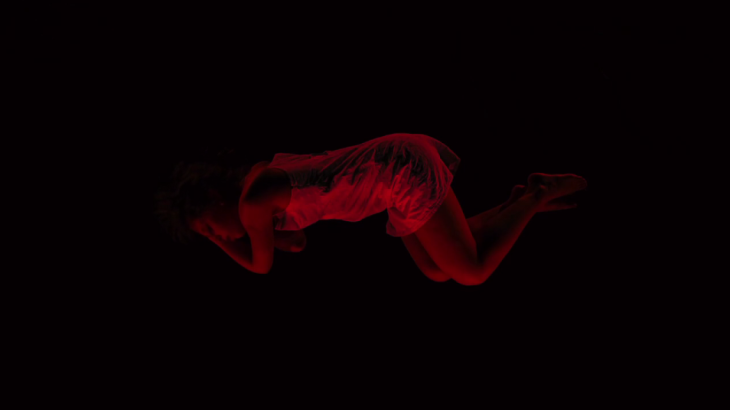Frightened and alone, a young woman (Becky Cofta) struggles to open up to a loved one, teetering on the brink of internal and literal devastation. Among the most purely cinematic entries in this year’s Wisconsin Film Festival, Greg Bishop’s Winterlude is tragically temporal with soundscapes that ring as cold and hollow as the Wisconsin wilderness it was shot around.
Despite Winterlude‘s arthouse opacity, Bishop has spent the last few years as a producer, editor and documentary filmmaker with a resume that spans video journalism for the Milwaukee Journal Sentinel and film projects at UW-Milwaukee, where Bishop graduated from last year. Winterlude marks a personal return to his early surrealist work, a Lynchian embrace of inevitability and seasonal change. As a continuation of our “5 Questions” series on “Wisconsin’s Own” filmmakers, Greg Bishop talked with me about preserving the abstract on set and how an apocalypse isn’t always a bad thing.
1. Winterlude has already played at the Beloit International Film Festival and Headwaters in Bemidji. What’s the audience response been to such a non-transparent film?
Beloit and Headwaters actually were Winterlude‘s second and third stops on the festival circuit. We premiered in Ontario in late 2014.
Having made surrealist films in the past, I was prepared for wildly different responses. Thus far, they’ve been pretty fascinating. I love hearing responses or interpretations to elements of Winterlude that I never considered in its narrative structure.
2. You’ve worked on several other projects, but this particular kind of filmmaking seems like a first-time experience for you. Were there any influences you drew from?
When I first started out, my films were generally surrealist in nature. I later drifted towards producing and documentary filmmaking for a few years but wanted to return to form with Winterlude, so imagine having a lot of pent-up ideas floating about for a while.
I’ve always been drawn to Akira Yamaoka’s industrial-ambient scores and how he is able to romanticize redundant mechanical noises. In addition, I was inspired early on by Buñuel/Dali’s Un Chien Andalou (1929) and the short films of David Lynch, particularly The Grandmother (1970) and The Alphabet (1968).
3. Your IndieGoGo campaign suggested Dundee and Shebyogan as filming locations, and you shoot a lot of scenes of outside. What made you decide to use open spaces in a story that can feel pretty claustrophobic?
The film is a reflection of personal entrapment and the desire to escape our aggressive surroundings: more directly, feeling trapped in my hole of an apartment and the personally brutal winter I was experiencing at the time. That said, the physical and abstract spaces reflect what we have, where we are and where we want to be. I chose the wilderness because it’s free, vast and brimming with life — a blunt contrast to the other spaces.
4. You have a pair of great actors that say a lot without speaking, but the sound is such an important element in establishing the atmosphere. Hollowed out noises, spacey synth textures, Cell the Rain Machine’s original score. How did you direct your actors knowing so much would be added in post?
The music and sounds were, for the most part, completed before principle photography. I did a lot of experimentation beforehand, mixing the sounds with the images, so much so that some of the pre-planned shots were either altered or removed entirely while on set based on the structure of the sounds and what I could do with them. I wanted to construct the soundscape entirely around the flow of images. In addition to the original score, there was one small piece of material by ambient artist Locust Toybox.
When filming with the actors, I don’t think I ever did on-set sound recording. To help maintain the mood and spirits, I played music while shooting or between takes — a mixture of The Walker Brothers, Bobby Vinton, Franki Valli and the original score. Nothing strictly abstract, but enough to balance tone. When directing the actors, I would talk it over and then walk them through the scene. I wanted their performances to reflect their surroundings, so to seem otherworldly and detached when standing in abstractness.
5. There’s an embrace of seasonal changes and the inevitability of “death” that comes with fall and winter. And Winterlude arrives at a kind of peace with this, albeit a slightly twisted one. Or am I way off base here?
I think you’re right on track, not just on finality but also about the parabolic nature of things. The title is inspired by this idea that most things we struggle through in life tend to reset themselves in some way by the winter, and that maybe we experience this phenomenon perpetually, especially if you consider the apocalyptic definition to be “to begin anew.”
- Winterlude screens before Sundance winner The Russian Woodpecker on Tues Apr 14 at 6:30p and Wed Apr 15 at 4:15p. Tickets for both shows are “rush only.”

